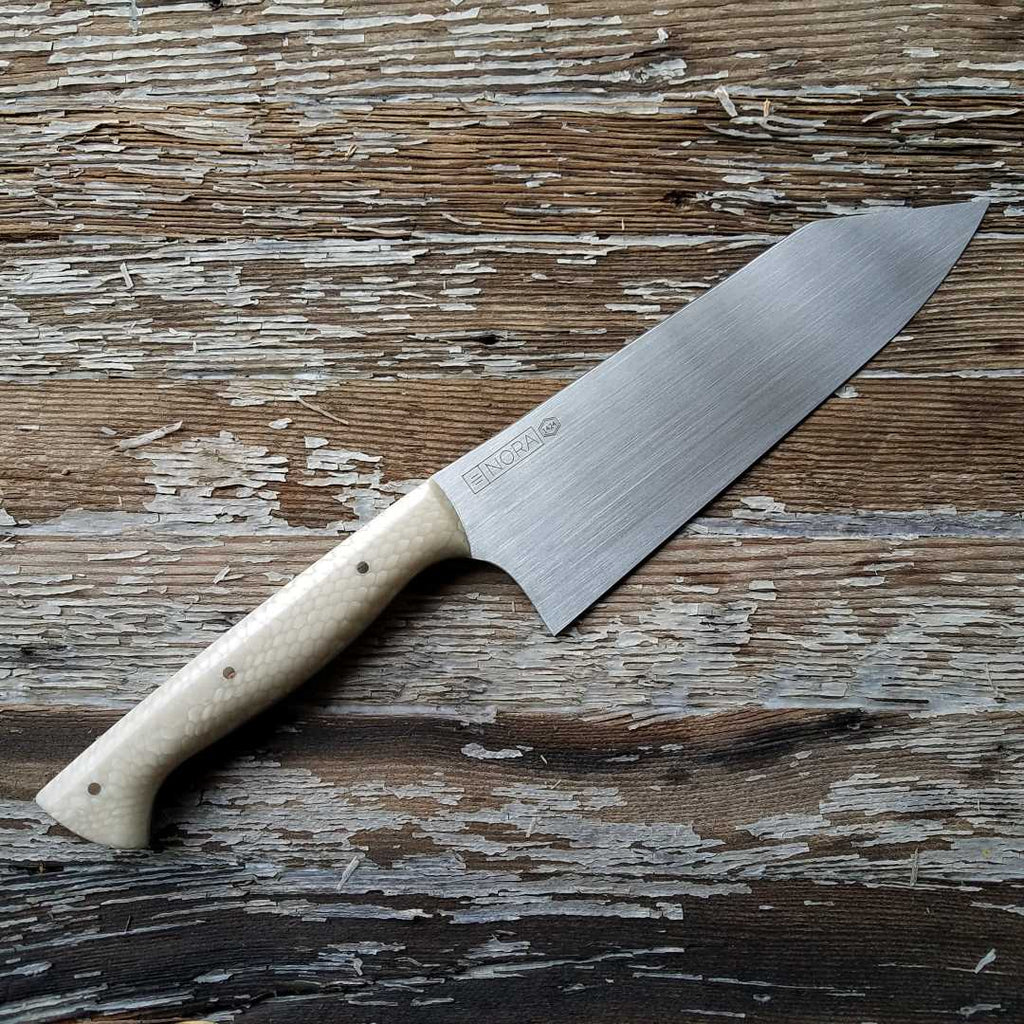
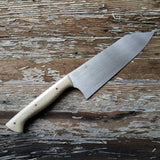
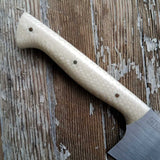
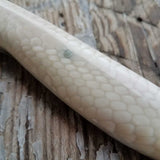
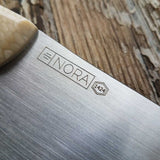
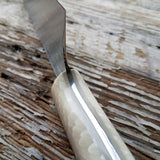
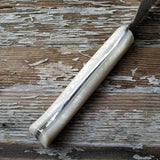
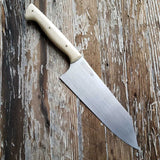
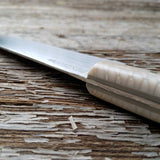
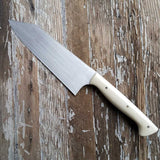
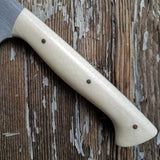
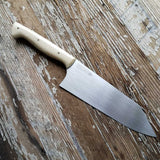
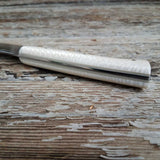
NORA #1424 - 7.5' AEB-L Stainless Kiritsuke - Ivory Juma
$ 339.00
KNIFE HIGHLIGHTS
- Blade Type: Kiritsuke
- Blade Length: 7.5 Inches
- Total Length: 11.65 Inches
- Handle Style: Western | Right or Left Hand Use
- Steel: AEB-L Stainless Steel
- Handle Materials: Ivory Juma, tan G10 liners, brass pins
- Rockwell Hardness: 62 HRC
- Grind Type: Full Flat Hybrid - Performance Grind (3 different bevels, blended)
- This Blade is Ground...
- Thin for Performance (best performance but delicate)
- Thick for Durability (tough, built to last for heavy wear-n-tear)
- >>> Mid-Range with Special Geometry (specially ground for food release and glide but blade is kept slightly thicker near spine for durability)
- This Knife Feels...
- Heavy in Hand (Hefty. Durable.)
- Light (nimble, maneuverable)
- >>>Not too heavy, not too light (Switzerland. Nicely balanced for the size of the knife.)
GENERAL USES OF THIS KNIFE:
KIRITSUKE KNIFE
This blade shape is our take on the traditional Japanese Kiritsuke knife.
A Kiritsuke knife is one of the very few Japanese knives that is considered multi-purpose. It is a hybrid between a Yanagi (fish slicer) and a Usuba (vegetable knife.). A Kiritsuke knife works well for slicing and breaking down protein but it also excels at vegetable prep. and general purpose tasks. In Japanese kitchens, the Kiritsuke knife is reserved only for the executive Chef as a sign of respect and also due to the skill needed to efficiently use these knives.
Our Kiritsuke design does not have as flat of a belly as the more traditional Japanese style knives. We have done this to allow just the slightest amount of rock in the cut. We feel it adds a bit more versatility to the knife.
HANDLE DESIGN & MATERIALS:
Every one of our knives is handmade, unique and numbered. This NORA has been handled with a material called Juma. Juma is a unique resin-based material that was originally used on pool cues and has been adapted for knife handling. The material is resin based and has a snakeskin like pattern that weaves in and out of focus through the material. We love the sleek look of this material and its nice that the handle is relatively low maintenance.
STEEL INFORMATION:
This knife blade is composed of AEB-L stainless steel which is a high-quality Swedish metal, originally developed for razor blades. Recently, steel suppliers have made this steel available in thicker sheets and it has proven to be an excellent adaptation for the cutlery industry.
AEB-L has a beautiful balance of carbon and chromium and, with proper heat treatment, this steel produces both a very fine edge as well as excellent toughness and edge stability. The fine grain structure also makes this steel very easy to sharpen. We believe it is one of the finest stainless steels available on the market today for use with kitchen knives.
As a side note, there are two things we like to mention about this steel:
1.) This steel responds beautifully to honing and if the knife is honed regularly it should need infrequent sharpening.
2.) AEB-L is a stainless steel but just barely. The concept of stainless steel is very misleading because every steel is, at some level, reactive to water and other elements.
The higher carbon content in this stainless is what allows it to get a fine edge and higher hardness compared to many other stainless steels but it also has a tendency to sometimes form very fine rust spots on the blade. If this happens, these are easily removed with a green or red scotch brite pad and usually the rough end of a kitchen sponge will also do the trick. Take extra care to remove any excess wetness that remain on this blade. Drip drying is NOT recommended.
